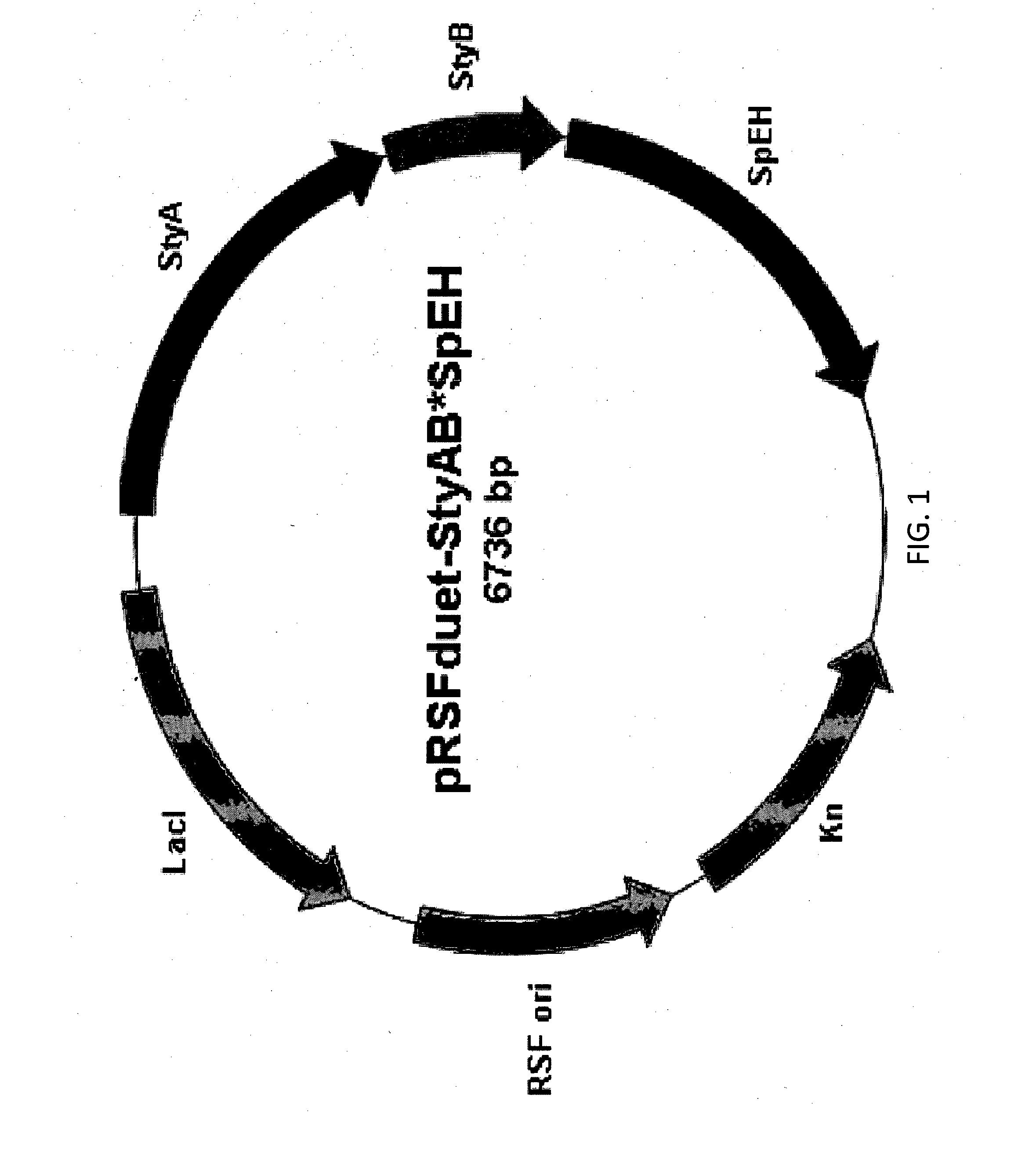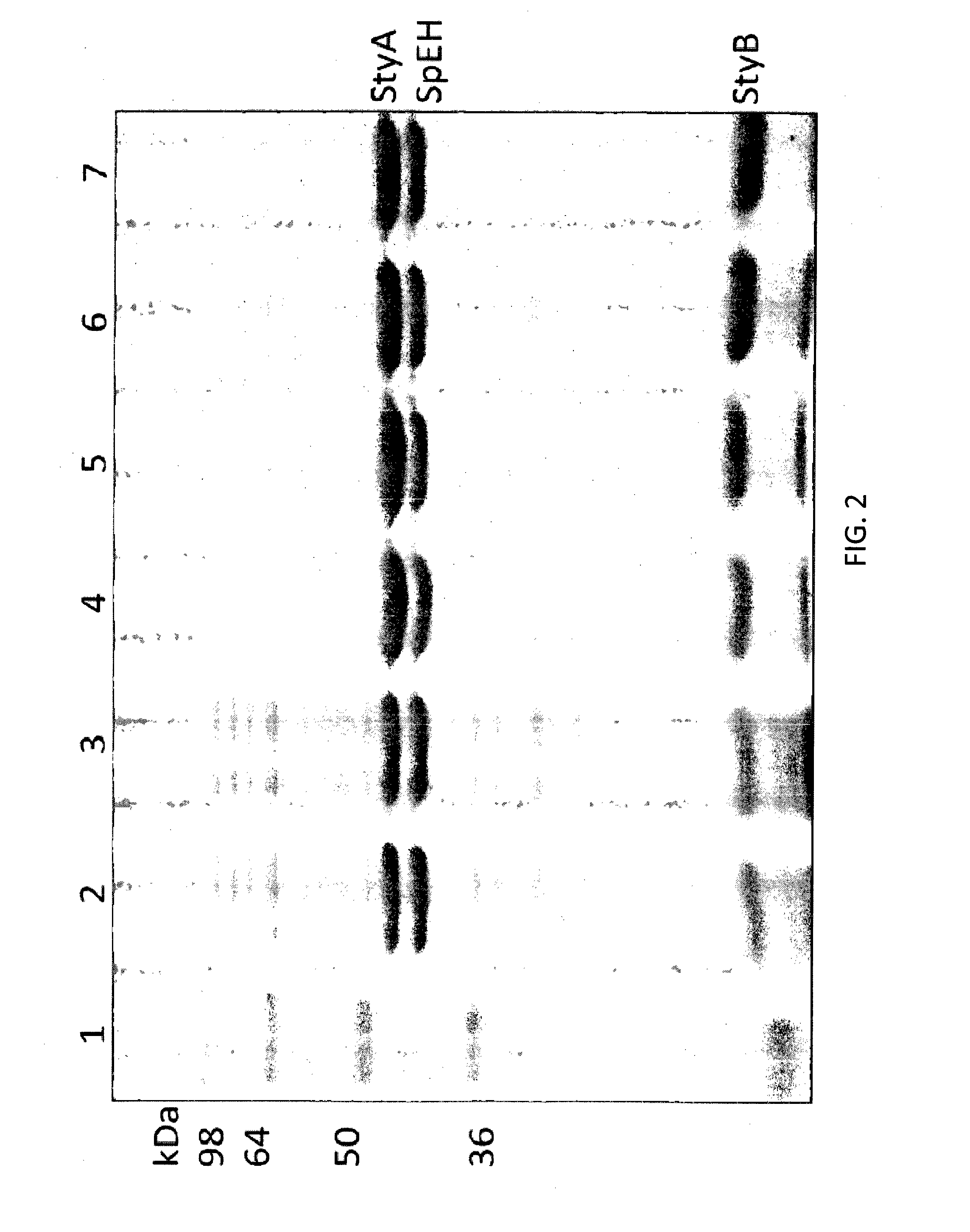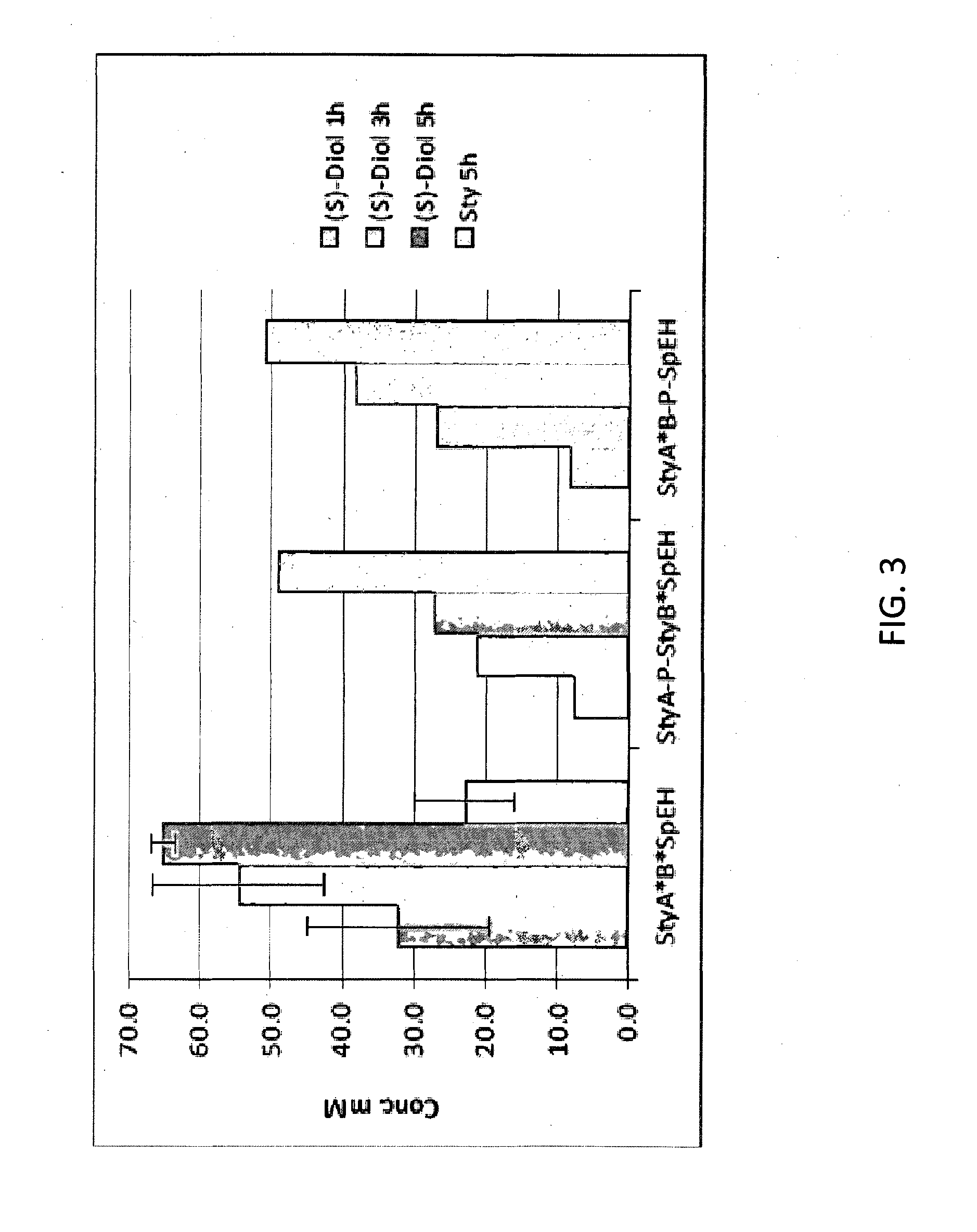Production Of Enantiopure alpha-Hydroxy Carboxylic Acids From Alkenes By Cascade Biocatalysis
a technology of cascade biocatalysis and enantiopure alpha-hydroxy carboxylic acids, which is applied in the direction of biochemistry apparatus and processes, microorganisms, enzymes, etc., to achieve the effect of high yield and high enantiomeric excess
- Summary
- Abstract
- Description
- Claims
- Application Information
AI Technical Summary
Benefits of technology
Problems solved by technology
Method used
Image
Examples
example 1
Genetic Engineering of E. coli Recombinant Expressing SMO and SpEH
[0061]The first enzyme, styrene monooxygenase (SMO), catalyzed the epoxidation of styrene to (S)-styrene oxide. The enzyme SMO was comprised of two components (polypeptides): StyA and StyB. In order to optimize the activity of SMO, these two components were expressed together in two ways: (1) two promoters respectively drove the expression of StyA and StyB, and the construction is P-StyA-P-StyB; (2) there was only one promoter and StyA and StyB were expressed as one operon (P-StyAB). In the construction of P-StyA-P-StyB, StyA was first cloned using the template pSPZ10 and the following primers: A CTG TCA TGA AAA AGC GTATCG GTA TTG TTG G (SEQ ID NO: 17) and A CTG GAA TTC TCA TGC TGC GAT AGT TGG TGC GAA CTG (SEQ ID NO: 18) to pRSFduet plasmid (available from Novagen) at NcoI and EcoRI restriction site to produce pRSFduet-StyA plasmid; and then StyB component was cloned by the primers A CTG CAT ATG ACG CTG AAA AAA GAT AT...
example 2
Production of (S)-Phenylethane-1,2-Diol from Styrene Via Cascade Biocatalysis Using E. coli Cells Expressing SMO and SpEH
[0063]
[0064]Three recombinant E. coli strains (T7 expression strain from NEB or BL21DE3 strain from Novagen) containing the plasmid P-StyA-P-StyB*SpEH, P-StyA*StyB-P-SpEH or P-StyA*StyB*SpEH were grown in 1 mL LB medium containing 50 mg / L kanamycin at 37° C. and then 2% inoculated into 25 mL TB medium (50 mg / L kanamycin). When OD600 reached 0.6, 0.5 mM IPTG was added to induce the expression of enzymes. The cells continued to grow and expressed protein for 12 hours at 22° C. before they were harvested by centrifuge (5000 g, 5 mins). The cells were resuspended in 100 mM KPB buffer (pH=8.0) to 10 g cdw / L and used in a buffer:hexadecane two-phase system (2 mL 2 mL) for biotransformation of 100 mM styrene (2% glucose for cofactor regeneration). The reaction was conducted at 30° C. and 300 rpm in a 100-mL flask for 5 hours. A 100 uL aqueous sample was taken during the ...
example 3
Production of Substituted (S)-Phenylethane-1,2-Diols from Substituted Styrenes Via Cascade Biocatalysis Using E. coli Cells Expressing SMO and SpEH
[0065]
[0066]In addition to non-substituted mandelic acid, many chiral substituted mandelic acids are also useful intermediates. To fully explore the potential for other substituted (S)-mandelic acids production, we first tested the existing system to produce the key intermediates, substituted (S)-phenylethane-1,2-diols. The E. coli (P-StyA*StyB*SpEH) was grown in 1 mL LB medium containing 50 mg / L kanamycin at 37° C. and then 2% inoculated into 25 mL M9-Glu-Y medium (standard M9 medium plus 20 g / L glucose and 5 g / L yeast extract) with 50 mg / L kanamycin. When OD600 reached 0.6, 0.5 mM IPTG was added to induce the expressing of enzymes. The cells continued to grow and expressed protein for 12 hours at 22° C. before they were harvested by centrifuge (5000 g, 5 mins). The cells were resuspended in 100 mM KPB buffer (pH=8.0) to 10 g cdw / L and u...
PUM
| Property | Measurement | Unit |
|---|---|---|
| Fraction | aaaaa | aaaaa |
| Fraction | aaaaa | aaaaa |
| Fraction | aaaaa | aaaaa |
Abstract
Description
Claims
Application Information
 Login to View More
Login to View More - R&D
- Intellectual Property
- Life Sciences
- Materials
- Tech Scout
- Unparalleled Data Quality
- Higher Quality Content
- 60% Fewer Hallucinations
Browse by: Latest US Patents, China's latest patents, Technical Efficacy Thesaurus, Application Domain, Technology Topic, Popular Technical Reports.
© 2025 PatSnap. All rights reserved.Legal|Privacy policy|Modern Slavery Act Transparency Statement|Sitemap|About US| Contact US: help@patsnap.com



